Temporary Protected Status for Somalia
Last Updated
The current 18-month grant of Temporary Protected Status, or TPS, for Somalia will expire on September 17, 2018 unless extended by the secretary of Homeland Security.[1] By statute, the DHS Secretary must decide whether to extend and/or redesignate or terminate TPS for Somalia by July 19, 2018.[2]
What is TPS?
Temporary Protected Status, or TPS, was established by Congress through the Immigration Act of 1990.[3] TPS is intended to protect foreign nations in the U.S. from being returned to their home country if it became unsafe during the time they were in the U.S. and would put them at risk of violence, disease or death.[4] Under the law, the secretary of Homeland Security may designate a foreign country for TPS in three scenarios:[5]
- Ongoing armed conflict (such as a civil war)[6]
- An environmental disaster (such as earthquake or hurricane), or an epidemic;[7] or
- Other extraordinary and temporary conditions that prevents nationals from the country from safely returning home[8]
TPS may be designated or extended in six, 12 or 18-month increments.[9] At least 60 days before the end of a designation period, the secretary of Homeland Security must review country conditions in consultation with appropriate agencies of the government, for example the State Department, and determine whether conditions warrant extension.[10] The decision must be published on a timely basis in the Federal Register.[11] Under the law, TPS may be extended as many times as necessary, as long as the dangerous country conditions continue.[12] TPS can also be redesignated for a country simultaneously with an extension or independently.[13]
Nationals of a TPS-designated country and people without nationality who last lived in a TPS-designated country, and who were physically in the United States when the designation was made and meet certain requirements, may be eligible for TPS.[14] If granted, recipients are temporarily protected from deportation and may receive work authorization to support themselves while they remain in the U.S.[15]
TPS does not provide a path to lawful permanent resident status or citizenship.[16]
Why was Somalia designated for TPS?
Somalia was originally designated for TPS on September 16, 1991 based on extraordinary and temporary conditions that prevented the safe return of TPS holders.[17] Somalia’s TPS designation was extended and redesignated on May 2, 2012, including ongoing armed conflict as a reason for the protection.[18] The country’s TPS designation was most recently extended in January 2017 due to ongoing armed conflict and persisting humanitarian crisis.[19] At the time of the extension, the U.S. government cited Somalia’s complex conflict and widespread violence involving Somali government forces, clan militia, African Union troops and al-Shabaab.[20] In particular, al-Shabaab’s frequent attacks on military and civilian targets were cited as making the country unsafe for the return of TPS holders.[21]
Widespread violence between clans also makes the safe return of Somali TPS holders impossible.[22] As part of inter- and intra-clan violence across the country, minority clans suffer systemic abuse and killings at the hands of more powerful clans.[23] Furthermore, minority clan members have also been largely displaced in Somalia; many are forced to survive in displaced persons camps.[24] The camps are notoriously unsafe. People are subjected to violence (including rape and physical attacks), prevented from accessing humanitarian aid and suffer other persecution and discrimination. [25]
Somalia continues to experience a complex and protracted emergency, one of the worst humanitarian crises in the world.[26] At the time of the last TPS extension in 2017, approximately 5 million people (about 40 percent of Somalia’s population) were in need of humanitarian assistance, and over a million people were internally displaced.[27] Food insecurity and malnutrition is widespread and deteriorating, with at least 1.1 million people suffering from acute food insecurity.[28] This crisis was intensified by the El Niño phenomenon of 2015 to 2016 which led to both extensive flooding and severe drought in much of the country.[29]
Drought also led to lack of access to safe drinking water and an increase in the spread of waterborne disease as people were forced to use unclean water sources, including water shared with livestock.[30] Over-strained health facilities are attempting to treat the increase in diseases associated with a lack of water and poor hygiene, including skin diseases, respiratory infections and febrile illnesses.[31] Approximately 3.2 million people in Somalia do not have access to emergency health care services, and 1.9 million people risk death from preventable diseases due to a lack of access to primary health care.[32] Somalia also has one of the highest maternal mortality rates in the world.[33]
Why should TPS for Somalia be extended and redesignated?
Somalia remains unable to welcome the safe return of TPS holders due to the ongoing violence and humanitarian crisis. There continues to be deadly armed conflict in Somalia between Somali government forces, militia, African Union troops and other foreign fighters against al-Shabaab.[34] The United Nations Assistance Mission in Somalia (UNSOM) reported 1,228 civilian casualties between January and September 2017 as a result of the conflict.[35] Not long after that report, the deadliest single attack in the country’s history occurred on October 14, 2017, when a truck filled with bombs exploded in Somalia’s capital city, Mogadishu, killing at least 358 people.[36] Somalia currently has a level 4 travel advisory from the U.S. State Department, which is the highest danger level given.[37] The travel advisory from January 2018 states, “do not travel to Somalia due to crime, terrorism, and piracy.”[38] Violent crime, such as kidnapping and murder, are common throughout Somalia.[39] Acts of terrorism, including kidnappings, bombings, and other attacks are also prevalent.[40]
Internal displacement continues to be a major problem as well, with over 1.5 million people currently internally displaced in Somalia and nearly 900,000 refugees in the nearby region.[41] According to the UN, Somali security forces destroyed 23 camps for internally displaced people on December 29 and 30, 2017, beating anyone who tried to resist or question them.[42]
Although large-scale humanitarian assistance and some improved rainfall has helped ease drought and reduce the risk of famine, food insecurity remains a massive crisis in Somalia.[43] An estimated 2.7 million people in Somalia are currently facing acute food insecurity, with an additional 2.7 million people experiencing stressed levels of food insecurity.[44] Due to below average rainfall that occurred from October to December 2017, the current agricultural harvest is expected to be below average as well.[45] In its most recent humanitarian situation report, UNICEF reported treating 54,071 children suffering from severe acute malnutrition in 2018, a 19 percent increase from the number of children treated for malnutrition in 2017.[46] Over 300,000 children under the age of five are severely malnourished, including 48,000 who face death if not urgently treated.[47]
Internal displacement in Somalia has also worsened since the last TPS extension due to other intervening factors. According to a report from the UN Office for the Coordination of Humanitarian Affairs, flash and river flooding that occurred in April of 2018 has affected an estimated 772,500 people and more than 229,000 have been displaced.[48] Several roads are now impassable, impacting commerce in the country and driving food prices still higher.[49] According to UNICEF, over 200,000 people are now living in congested, unsanitary conditions that breed disease.[50] Cases of cholera are expected to rise as flood waters stagnate and remaining clean drinking water sources are compromised.[51]
What will the impact be if TPS for Somalia is not extended and redesignated?
Approximately 250 Somalis in the United States are protected from the ongoing conflict and humanitarian crisis in Somalia through TPS. The risk of violence remains high as the country continues to be rocked by conflict between government forces, al-Shabaab, clans and other factions. Additionally, despite efforts to alleviate the humanitarian crisis, recent intervening factors like mass flooding have increased internal displacement and worsened food insecurity and risk of famine across the country. Due to the violence and persisting lack of access to basic needs, including lack of food, clean water, and healthcare, as well as widespread disease, terminating TPS would put families with U.S. citizen children in impossible situations—bring children into harm’s way or tear families apart. These factors compel the secretary of Homeland Security to both extend TPS for 18 months and to redesignate to allow more recently arrived Somalis to be eligible to apply for protection through TPS.
When the state department issued a level 4 travel advisory, it sent a clear it sent a clear signal that travelling to Somalia would be an extremely risky decision for American travelers.[52] If Somalia is too dangerous for U.S. citizens to temporarily travel, then it is certainly too dangerous to send back Somali nationals and their families to permanently live. TPS must be extended for 18 months and redesignated.
Why is extending and redesignating TPS for Somalia in line with American values and interests?
The United States has a long history of providing relief to victims of catastrophic events, war, violence and natural disasters. TPS reflects our country’s values, codified in the statute, by protecting people from unsafe conditions outside of their control.
Americans hold themselves to high standards when it comes to the humane treatment of people. U.S. immigration law, including TPS, reflects respect for the lives of people who, without protection, would be returned to hazardous, if not deadly, circumstances.
American interfaith values demand that the United States extend TPS to protect the lives and dignity of Somali TPS recipients. Continued TPS for Somalia satisfies our moral and international obligations until greater progress is made to ensure innocent people are not returned to dangerous conditions.
[1]
See 82 Fed. Reg. 4905 (Jan. 17, 2017), www.federalregister.gov/documents/2017/01/17/2016-31861/extension-of-the....
[2]
INA § 244; 82 Fed. Reg. 4905 (Jan. 17, 2017), www.federalregister.gov/documents/2017/01/17/2016-31861/extension-of-the....
[3]
Jill H. Wilson, Temporary Protect Status: Overview and Current Issues, Congressional Research Service (Jan. 17, 2018), https://fas.org/sgp/crs/homesec/RS20844.pdf.
[4] Id.
[5] INA §244 (b).
[6] INA §244 (b)(1)(A).
[7] INA §244 (b)(1)(B).
[8] INA §244 (b)(1)(C).
[9] INA §244 (b)(2)(B).
[10] INA §244 (b)(3)(A).
[11] Id.
[12] See generally INA §244.
[13] Id.
[14] INA §244 (a)(1).
[15] INA §244 (a)(1)(A); INA §244 (a)(1)(B)
[16] See generally INA §244.
[17] 56 Fed. Reg. 46804 (Sept. 16, 1991).
[18]
77 Fed. Reg. 25723 (May 1, 2012), www.federalregister.gov/documents/2012/05/01/2012-10388/extension-and-re....
[19]
82 Fed. Reg. 4905 (Jan. 17, 2017), www.federalregister.gov/documents/2017/01/17/2016-31861/extension-of-the....
[20] Id.
[21] Id.
[22] Id.
[23] Id.
[24] Id.
[25]
82 Fed. Reg. 4905 (Jan. 17, 2017), www.federalregister.gov/documents/2017/01/17/2016-31861/extension-of-the....
[26] Id.
[27] Id.
[28] Id.
[29] Id.
[30] Id.
[31] Id.
[32] Id.
[33] Id.
[34] World Report 2018: Somalia, Human Rights Watch (2018), www.hrw.org/world-report/2018/country-chapters/somalia.
[35] Id.
[36] Id.
[37]
Somalia Travel Advisory, Dept. of State (Jan. 10, 2018), travel.state.gov/content/travel/en/traveladvisories/traveladvisories/somalia-travel-advisory.html.
[38] Id.
[39] Id.
[40] Id.
[41] Somalia Situation 2017, UNHCR (May, 2017), www.unhcr.org/591ae0e17.pdf.
[42]
Moulid Hujale, ‘People were Screaming’: Troops Destroy $200,000 Aid Camps in Somalia, The Guardian (Jan. 15, 2018), www.theguardian.com/global-development/2018/jan/15/troops-destroy-aid-ca....
[43] Food Assistance Fact Sheet- Somalia, USAID (May 4, 2018), www.usaid.gov/somalia/food-assistance.
[44] Id.
[45] Id.
[46]
UNICEF Somalia Humanitarian Situation Report, Relief Web (Apr. 2018), reliefweb.int/report/somalia/unicef-somalia-humanitarian-situation-report-3-1-31-march-2018.
[47] Id.
[48]
OCHA Somalia Flash Update #5- Humanitarian Impact of Heavy Rains, Relief Web (May 16, 2018), reliefweb.int/report/somalia/ocha-somalia-flash-update-5-humanitarian-impact-heavy-rains-15-may-2018-enso.
[49] Id.
[50]
Lisa Schlein, Children at Risk of Death from Heavy Flooding in Somalia, Voice of America (June 9, 2018), www.voanews.com/a/children-disease-death-somalia-flooding/4431732.html.
[51]
OCHA Somalia Flash Update #5- Humanitarian Impact of Heavy Rains, Relief Web (May 16, 2018), reliefweb.int/report/somalia/ocha-somalia-flash-update-5-humanitarian-impact-heavy-rains-15-may-2018-enso.
[52]
Somalia Travel Advisory, Dept. of State (Jan. 10, 2018), travel.state.gov/content/travel/en/traveladvisories/traveladvisories/somalia-travel-advisory.html.






